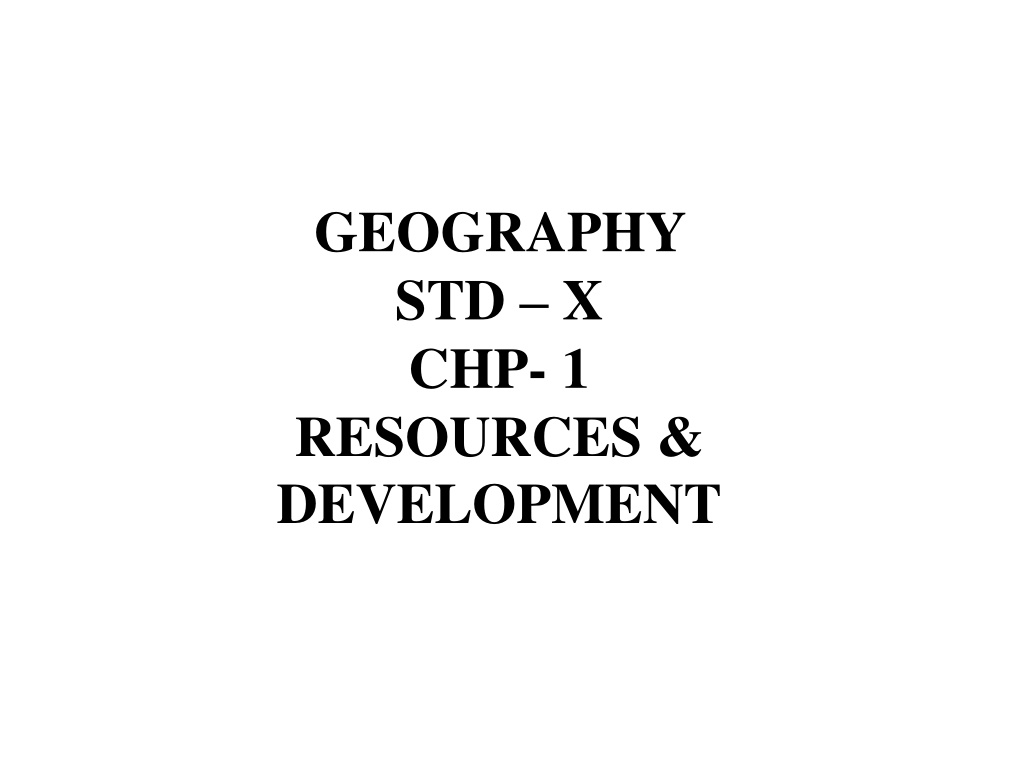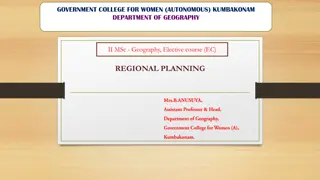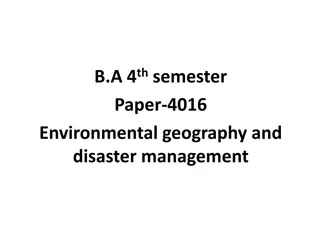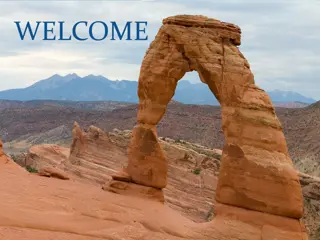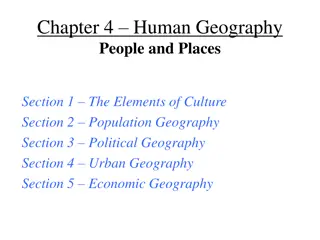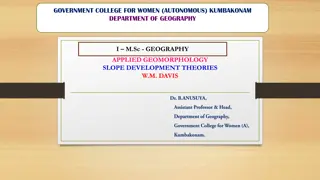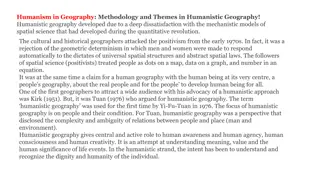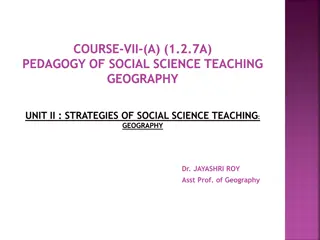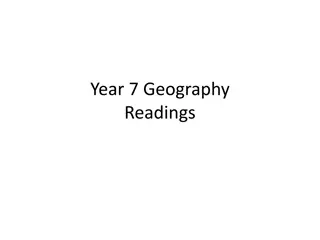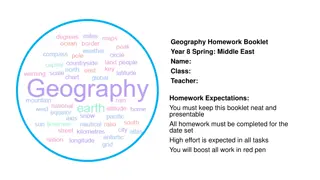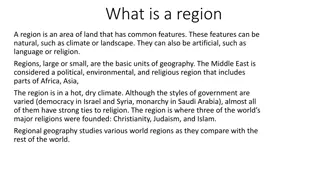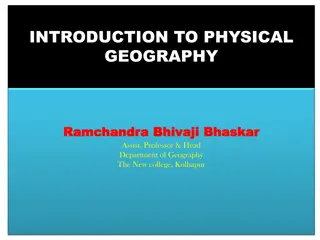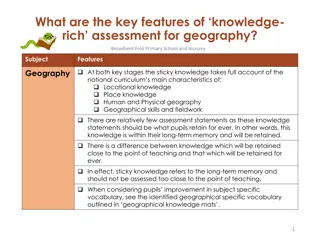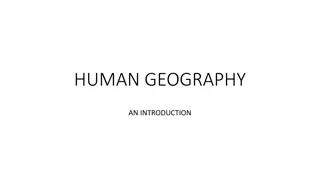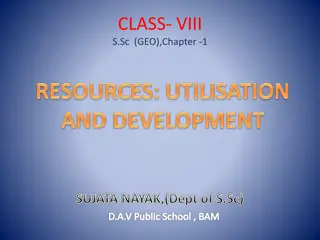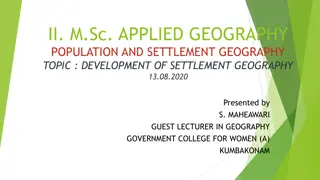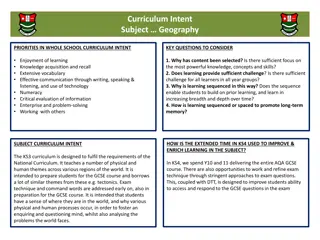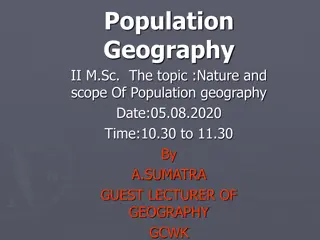Understanding Resources and Development in Geography
Resources in our environment, essential for satisfying needs, are classified based on origin, exhaustibility, ownership, and development potential. Human beings are key in transforming materials into usable resources. Various types of resources are explored, from biotic to abiotic, renewable to non-renewable, individual to international ownership, and exploited to undeveloped potential.
Download Presentation

Please find below an Image/Link to download the presentation.
The content on the website is provided AS IS for your information and personal use only. It may not be sold, licensed, or shared on other websites without obtaining consent from the author. Download presentation by click this link. If you encounter any issues during the download, it is possible that the publisher has removed the file from their server.
E N D
Presentation Transcript
GEOGRAPHY STD X CHP- 1 RESOURCES & DEVELOPMENT
GEOGRAPHY STD X CHP- 1 RESOURCES & DEVELOPMENT WHAT IS A RESOURCE? Everything available in our environment which can be used to satisfy our needs, provided it is technologically accessible, economically feasible & culturally acceptable is called a Resource. This figure shows human beings as the essential component of resource. They transform material available in our environment by using technology in various institutions into resources.
CLASIFICATION OF RESOURCES Resources can be classified in the following ways: On the basis of origin Biotic & Abiotic Resources Biotic Resources- They are obtained from biosphere & have life. Eg. Human Beings, Flora, Fauna etc. Abiotic Resources- All things which are composed of non living things. Eg. Rocks, Metals, etc. On the basis of exhaustibility - Renewable & Non Renewable Resources Renewable Resources- Resouces which can be renewed or reproduced by physical, chemical or mechanical processes. Eg. Forests, Solar Energy, Wind Energy etc. Non-Renewable Resources- These resources take millions of years in their formation. Eg. Minerals, Fossil Fuels etc.
On the basis of ownership Individal Resources- They are owned privately by individuals. Eg. Plots, Houses etc. Community Owned Resources There are resources which are accessible to all the members of the community. Eg. Burial Grounds, Public Parks etc. National Resources Resources that belong to a nation. Eg. Minerals, Water Resource, Wildlife etc. International Resources Resources which are regulated by international institutions. Eg. Ocean resources beyond 200 nautical miles is Exclusive Economic Zone. On the basis of Status of Development Potential Resources - Resources which are found in a region but have not been utilised. Eg. Rajasthan & Gujarat have enormous potential for the development of wind & solar energy, but so far these have not been developed properly.
Developed Resources - Resources which are surveyed & their quality and quantity have been determined for utilisation. They mainly depend on technology & level of their feasibility. Stock Materials in the environment which have the potential to satisfy human needs but human beings do not have the appropriate technology to access these. Eg. Water is a compound of 2 gases, H & O2. Hydrogen can be used as a rich source of energy but due to technical know-how , it is considered as stock. Reserves - It is a subset of the stock which can be put into used with the use of existing technical know-how but their use has not been started. They can be used for meeting future requirements. Eg. Water in dams, etc.
DEVELOPMENT OF RESOURCES Resources are vital for human survival as well as for maintaining the quality of life. As a result, human beings used them indiscriminately which has led to the following major problems : Depletion of Resources for satisfying the greed of few individuals. Accumulation of Resources in few hands which in turn divided the society into rich & poor. Indiscriminate exploitation of resources has led to global ecological crisis such as global warming, ozone layer depletion, environmental pollution & land degradation. Therefore resource planning is essential for sustainable existence of all forms of life.
RESOURCE PLANNING Planning is very important for the judicious use of resources. It is very important for a country like India which has enormous diversity in the availability of resources. There are regions which are rich in certain types of resources but are deficient in some other resources. For Eg. Arunachal Pradesh has abundance of water resource but lacks in infrastructural development. Thus, Resource Planning is highly essential which involves the following steps: i.Identification & inventory of Resources that involves surveying, mapping& qualitative & quantitative estimation. ii.Evolving a planning structure with appropriate skills & technology. iii.Matching the resource development plans with overall national development plans.
LAND RESOURCES Land is an asset of a finite magnitude, therefore, it is important to use the available land for various purposes with careful planning as it supports natural vegetation, wildlife, human life, economic activities, transport & communication systems etc. India has a variety of relief features namely mountains, plateaus & plains etc. Plains constitutes 43% which provides facilities for agriculture & industries. Mountains account for 30% & ensure perennial flow of rivers while Plateaus constitutes 27% & posses rich reserves of minerals, fossil fuel & forests.
LAND UTILISATION & LAND USE PATTERN IN INDIA Land Resources are used for the following purposes: Forests Barren & Waste Land Land put to non agricultural uses like roads, buildings etc. Permanent Pasture Land Cultruable Waste Land Land under miscellaneous tree crops Fallow land Net Sown Area The use of land is determined both by physical factors such as topography, climate, soil types as well as human factors such as population density, technological capability etc.
The latest comparative use of land pattern has been given below: Q1. Find out reasons for the low proportion of net sown area. Q2. Give reason to why there is an increase in forest cover by 2014-15.
LAND DEGRADATION The process by which the land loses its fertility by various human activities like deforestation, over grazing, mining, quarrying etc is called Land Degradation CAUSES FOR LAND DEGRADATION: Mining sites are abandoned after excavation work like in Jharkhand, Chattisgarh etc. Deforestation due to mining activities. Overgrazing activities like in Gujarat, Rajasthan etc. Over-irrigation in states of Punjab, Haryana etc. have resulted in land degradation due to water logging that has increased the salinity & alkalinity in the soil. Mineral processing like grinding of limestone for cement industry have generated huge quantity of dust in the atmosphere which has retarded the process of infiltration of water into the soil. Industrial effluents as wastes have increased land & water pollution.
CONSERVATION MEASURES Afforestation programme Proper management of grazing land Planting of shelter belts of plants Control over grazing Stabilisation of sand dunes by growing thorny bushes Control of mining activities Proper management of waste lands Proper discharge & disposal of industrial wastes What is Soil? It is the most renewable natural resource which acts as a medium of plant growth & supports different types of living organisms on earth.
CLASSIFICATION OF SOIL Alluvial Soil Most widely spread & consists of various proportions of sand, silt & clay It is classified into two : Bhangar (old aluvium) & Khadar (new aluvium) This soil consists of adequate proportions of Potash, Phospheric acid & Lime Mostly found in Northern Plains & Deltaic regions Black Soil It is black in colour due to cooling of Lava flow Also known as Regur soil & most ideal for growing cotton. They are clayey in nature, so can hold moisture They are rich in Calcium Carbonate, Magnesium, Potash & Lime Mostly found in Maharashtra, Gujarat & Madhya Pradesh
Red & Yellow Soil This soil develops on crystalline igneous rocks in areas of low rainfall It develops a reddish colour due to diffusion of iron in crystalline & metamorphic rocks It looks yellow when it occurs in a hydrated form Mostly found in Odisha, Chattisgarh etc Laterite Soil This type of soil develops in areas with high temperature & heavy rainfall As a result of intense leaching & heavy rain the humus content of the soil is low as most of the micro organisms especially bacteria get destroyed Mostly found in Karnataka, Kerala, Tamil Nadu etc
Arid Soil They are generally sandy in texture & saline in nature Due to high evaporation of water in some areas the salt content is very high The soil lacks humus & moisture Kankar layers are seen in the bottom horizons which restrict the infiltration of water Mostly found in Rajasthan Forest Soil This type of soil is found in hilly & mountainous areas where sufficient rain forests are available They are loamy & silty in valley sides & coarse grained in the upper slopes They are acidic in nature with low humus content Mostly found in Jammu Kashmir, Sikkim etc
SOIL EROSION & CAUSES The denudation of the soil cover & subsequent washing down is called Soil Erosion. Its main causes are Deforestation, Over Grazing, Mining & Construction, Natural forces like Wind, Glacier & Water etc. SOIL CONSERVATION METHODS Ploughing along the contour lines Cutting down steps on the slopes Terrace cultivation Strip cropping Planting lines of trees to create shelter belts Stabilising of sand dunes by growing thorny bushes at the edges of deserts
HOME ASSIGNMENT 1. 2. On the political map of India, locate & label the different types of soil found in India. Solve the puzzle by following your search horizontally & vertically to find the hidden answers ********* - Mrs. Shyama Barpanda TGT (GEOGRAPHY)
